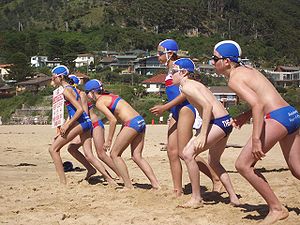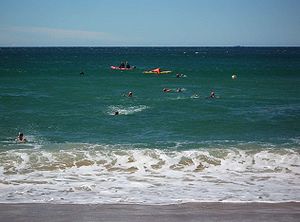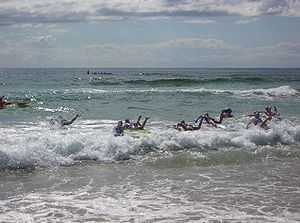
Nippers
Encyclopedia



Nippers learn about safety at the beach. They learn about dangers such as rocks, and animals (e.g. the blue-ringed octopus
Blue-ringed octopus
The blue-ringed octopuses are three octopus species that live in tide pools in the Pacific Ocean, from Japan to Australia . They are currently recognized as one of the world's most venomous marine animals...
), and also about surf conditions, such as rip current
Rip current
A rip current, commonly referred to by the misnomer rip tide, is a strong channel of water flowing seaward from near the shore, typically through the surf line. Typical flow is at 0.5 metres per second , and can be as fast as 2.5 metres per second...
s, sandbars, and waves
Ocean surface wave
In fluid dynamics, wind waves or, more precisely, wind-generated waves are surface waves that occur on the free surface of oceans, seas, lakes, rivers, and canals or even on small puddles and ponds. They usually result from the wind blowing over a vast enough stretch of fluid surface. Waves in the...
. Older Nippers also learn some basic first aid
First aid
First aid is the provision of initial care for an illness or injury. It is usually performed by non-expert, but trained personnel to a sick or injured person until definitive medical treatment can be accessed. Certain self-limiting illnesses or minor injuries may not require further medical care...
and may also learn CPR
Cardiopulmonary resuscitation
Cardiopulmonary resuscitation is an emergency procedure which is performed in an effort to manually preserve intact brain function until further measures are taken to restore spontaneous blood circulation and breathing in a person in cardiac arrest. It is indicated in those who are unresponsive...
when they reach the age of 13.
When Nippers are thirteen years old they can complete their SRC (Surf Rescue Certificate) enabling them to patrol beaches and partake in Senior Competition.
Like their Senior counterparts, Nippers participate in regular competition against other Surf Lifesaving Clubs, at sports carnival
Sports carnival
In Australian culture sports carnivals are held to perform competitions in the individual or team disciplines like athletics, swimming or Surf Life Saving. Teams from different clubs or schools gather together for both individual point-score and team score...
s. Nippers are able to participate in a variety of Individual and Team events, including beach sprints, Flags
Flags (sport)
Beach Flags is a sporting event used by Surf lifesavers to practice beach sprinting and reflexes.The game is played by sticking a series of flags into the sand in a row. The competitors lie facing away approximately 20 metres away. Upon a starting signal, the competitors race to the flags and try...
, swimming and board races, relays, March Past, etc. Unlike Seniors, Nippers do not compete in surf ski or surf boat races, and they also use shorter Surf Boards than their Senior counterparts. Nippers start to compete when they are in the Under 8s age group.
The name and availability of the preschool age group varies from club to club. These groups, sometimes called Tiny Tots or "Beach Worms", do not compete or learn first aid and surf awareness. Tiny Tots' activities include games, wading and paddling.
The nippers were sponsored from approximately 1909 by South Leagues club hens up until recently the caps were colored in the "Rabbitohs" red and green.
Nippers was supposedly started by Nambucca Heads Surf Life Saving Club on the North Coast.

